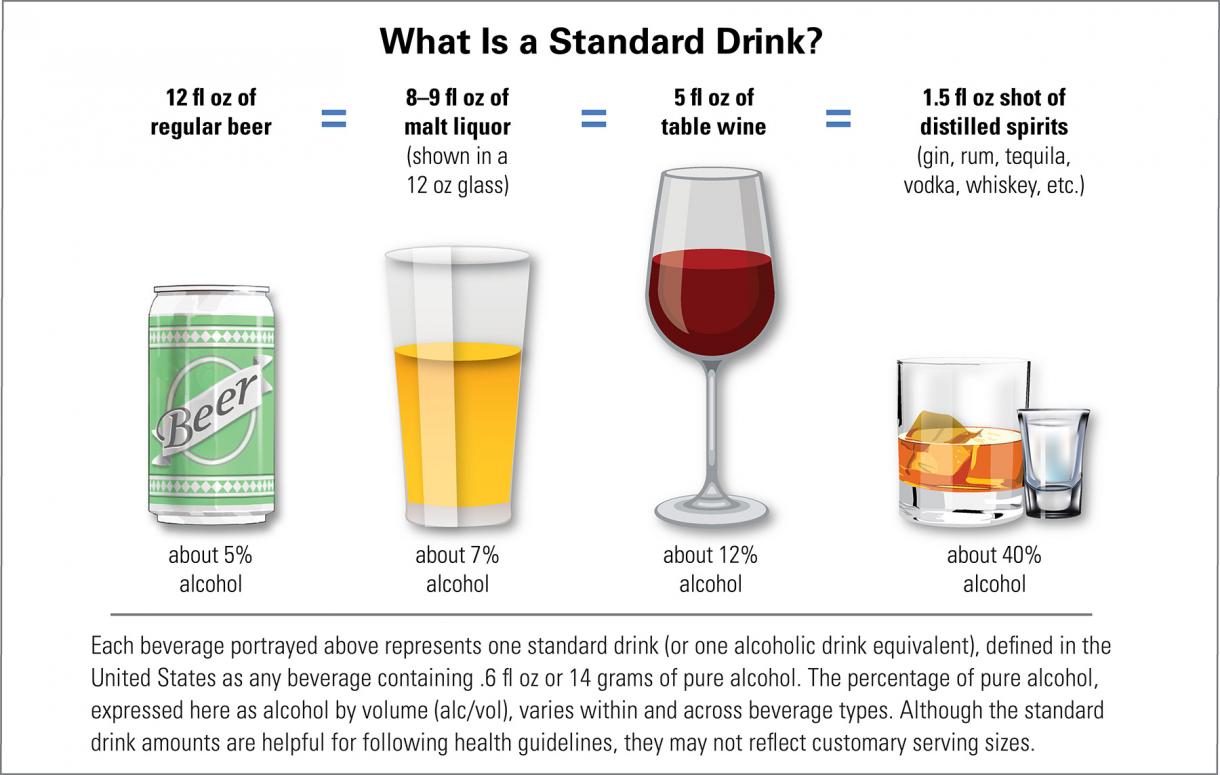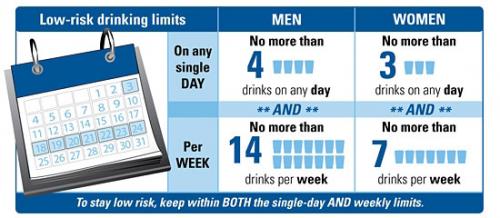
- What is a Drug?
- Understanding the Differences
- Substance Use Disorder (Addiction, Drug Dependence, Alcohol Dependence or Alcoholism)
- Drugs of Abuse and Their Effects
- Video: National Geographic - The Science of Addiction
- Alcohol Facts
- Signs of Alcohol Misuse
- What is Problem Drinking? (Abuse)
- Drinking Levels Defined
- What is Risky Drinking?
- Helping Someone with a Drinking Problem
- Quick Facts on Drug Addiction
What is a Drug?
A drug is a chemical substance that can change how your body and mind work. Drugs that can be dangerous are ones that people use to "get high" and change the way they feel (e.g., drugs like marijuana, cocaine, or heroin). They can also be drugs sold legally to adults everywhere, like alcohol and tobacco.
Medicines can also be misused when people take them to "get high" instead of the way their doctor advises. People can even misuse cough or cold medicines from the store if they ignore the directions and take too much at one time.
Understanding the Differences
The terms substance use, abuse, and dependence (or sometimes addiction) are used frequently – and sometimes interchangeably – when talking about alcohol and drugs. But what do they really mean?
- Use: Any consumption of alcohol and/or drugs. Something as commonplace as having a beer with friends during dinner is considered substance use. Substance use can lead to abuse or dependency in some people.
- Abuse: When someone continues to use drugs and/or alcohol even when it causes problems, such as trouble with work, family, or their health. For instance, continuing to use drugs knowing you’ll be fired if you fail a drug test is a sign of abuse.
- Dependence: Addiction to alcohol and/or drugs. You may be unable to stop drinking or using drugs and you develop physical withdrawal symptoms when you try to quit.
Substance Use Disorder (Addiction, Drug Dependence, Alcohol Dependence or Alcoholism)
Even with these three definitions in mind, it may still be difficult to distinguish between use, abuse, and dependence. For this reason, the American Psychiatric Association has updated its criteria for talking about addiction and now uses the term “substance use disorder,” which includes the following signs and symptoms:
- Using substances in larger amounts for longer than intended.
- Making efforts to stop, but being unable to do so.
- Spending more time getting, using, and recovering from using the substance.
- Having cravings and urges to use the substance.
- Continuing to use the substance even though it causes social and relationship problems.
- Giving up important social, work, and recreational activities because of the substance.
- Taking increased risks related to the substance.
- Continuing to use the substance when the user is aware it causes psychological or physical problems.
- Needing more of the substance to get the same effect, known as tolerance.
- Developing withdrawal symptoms when stopping the substance, known as physical dependence.
The more of these signs or symptoms a person struggles with, the greater their substance use disorder. A person who meets none of these criteria likely does not have a problem with drugs or alcohol, while someone meeting six or more of these signs may have an addiction.
Drugs of Abuse and Their Effects
| Category | Examples | Examples of General Effects |
|---|---|---|
| Alcohol | beer, wine, spirits | impaired judgment, slowed reflexes, impaired motor function, sleepiness or drowsiness, coma, overdose may be fatal |
| Cannabis | marijuana, hashish | distorted sense of time, impaired memory, impaired coordination |
| Depressants | sleeping medicines, sedatives, some tranquilizers | inattention, slowed reflexes, depression, impaired balance, drowsiness, coma, overdose may be fatal |
| Hallucinogens | LSD, PCP, Ecstasy MDMA mescaline | inattention, sensory illusions, hallucinations, disorientation, psychosis |
| Inhalants | hydrocarbons, solvents, gasoline | intoxication similar to alcohol, dizziness, headache |
| Nicotine | cigarettes, chewing tobacco, snuff, glue | initial stimulant, later depressant effects |
| Opiates | morphine, heroin, codeine, some prescription pain medications, fentanyl | loss of interest, "nodding", overdose may be fatal. If used by injection, the sharing of needles may spread Hepatitis B or C, and HIV/AIDS. |
| Stimulants | cocaine, amphetamines, crystal meth | elevated mood, overactivity, tension/anxiety, rapid heartbeat, constriction of blood vessels |
(Source: Blume, S.B., Alcohol and Drug Abuse in the Encyclopedia of Occupational Health and Safety 4th edition, International Labor Office, 1998)
National Geographic - The Science of Addiction
It’s important to keep in mind that only a mental health professional or addiction specialist can make an accurate diagnosis of a substance use disorder. If you think you may have a problem with alcohol or drugs, contact PAS at 919-416-1727 for a confidential appointment. You can also speak with your doctor to get the help you need.
Alcohol Facts
Drinks like beer, malt liquor, wine, and hard liquor contain alcohol. Hard liquor - such as whiskey, rum, or gin - has more alcohol in it than beer, malt liquor, or wine.

Photo by: The National Institute of Alcohol Abuse and Alcoholism
Signs of Alcohol Misuse
Drinking alcohol, known as use, is not necessarily a problem, but drinking too much can cause bad things to happen. People who drink too much alcohol might forget things that happened when they were drunk. This is called a blackout.
People who misuse alcohol, or people who are addicted, start having to drink more and more to get drunk. This is called tolerance. They might have a drink in the morning to calm down or stop a hangover. They might drink alone and they might keep it a secret.
What is Problem Drinking?
Problem drinking, or abuse, is using alcohol in ways that are harmful to the drinker or to others. People who are problem drinkers may have the disease of alcoholism or may drink in ways that lead to health and/or safety problems for themselves or others.
Drinking Levels Defined
NIAAA's Definition of Drinking at Low Risk for Developing Alcohol Use Disorder (AUD):
For women, low-risk drinking is defined as no more than 3 drinks on any single day and no more than 7 drinks per week. For men, it is defined as no more than 4 drinks on any single day and no more than 14 drinks per week. NIAAA research shows that only about 2 in 100 people who drink within these limits have AUD.

Moderate Alcohol Consumption:
Up to 1 drink per day for women and up to 2 drinks per day for men.
Binge Drinking:
Binge drinking is a pattern of drinking that brings blood alcohol concentration (BAC) levels to 0.08 g/dL. This typically occurs after 4 drinks for women and after 5 drinks for men—in about 2 hours. (NIAAA)
Binge drinking is 5 or more alcoholic drinks for males or 4 or more alcoholic drinks for females on the same occasion (i.e., at the same time or within a couple of hours of each other) on at least 1 day in the past month. Source: Substance Abuse and Mental Health Services Administration (SAMHSA)
Heavy Alcohol Use:
SAMHSA defines heavy alcohol use as binge drinking on 5 or more days in the past month.
What is Risky Drinking?
Risky drinking is drinking in ways that are likely to lead to trauma or adverse health effects, including alcoholism. Examples of risky drinking include drinking while underage, while taking medication, while engaging in mobile activities, or while having a strong family history of alcoholism.
Helping Someone with a Drinking Problem
You may know someone with a drinking problem and want to help, but are uncertain about how to do so. Remember, you are not expected to "save" this person or to become a counselor for this person. However, by educating yourself about alcohol issues and by gathering support for yourself, you can better help the problem drinker.
- Educate yourself about alcoholism/substance abuse and local resources before you need to use them.
- Raise the issue in a caring way. Express concern and cite behaviors you have noticed so you can address both the actions of the person and the frequency of behavior. Choose a location and time where you can speak in private — unless the person could be harmful to self or others.
- Be prepared for a negative response from the problem drinker. Do everything you can to remain calm and objective. Expect the person to be angry and defensive. Do not take the comments made to you personally.
- State consequences for the person continuing to drink without getting help. They could range from "I will continue to build resentment in this marriage" or "I am going to stop covering for you with your parents" to "I am leaving you." You could choose to say that you must limit your interactions with the person (such as a friend or family member) if he/she continues to drink. If the person could become dangerous, perhaps you need to address domestic violence or suicidal issues before the drinking problem can be discussed in a safer, controlled environment (like a counseling office or in a psychiatric facility).
- If he/she responds positively, have a plan. "Let's make an appointment at PAS for Wednesday" or "I know our insurance covers alcohol treatment at Center A so let's go there tonight for a substance abuse evaluation for you."
- Striking while the iron is hot is most true in substance abuse treatment. Plan to follow through with your goals as soon as possible with the individual — in the same day, if possible. Problem drinkers often change their minds about getting help as time passes. Denial plays a big part in this change.
- Continue to support the problem drinker through treatment/recovery by attending family or marital sessions at the facility. Attend Al-Anon as frequently as possible and try different groups (at least six) before deciding on one. Get phone numbers of members who are willing to serve as a support system for you. All of this is easier to do with help from others who have been there themselves.
For a confidential assistance to discuss your concerns about how alcohol or drugs may be affecting you or a family member, contact PAS at 919-416-1727 for an appointment.
Quick Facts on Drug Addiction
- According to the National Survey on Drug Use and Health (NSDUH), 21.5 million American adults (aged 12 and older) battled a substance use disorder in 2014.
- Almost 80 percent of individuals suffering from a substance use disorder in 2014 struggled with an alcohol use disorder (NSDUH).
- Over 7 million Americans in 2014 battled a drug use disorder (NSDUH).
- One out of every eight people who suffered from a drug use disorder in 2014, according to NSDUH, struggled with both alcohol and drug use disorders simultaneously.
- The Substance Abuse and Mental Health Services Administration (SAMHSA) published that in 2014, almost 8 million American adults battled both a mental health disorder and a substance use disorder, or co-occurring disorders.
- Drug abuse and addiction cost American society close to $200 billion in healthcare, criminal justice, legal, and lost workplace production/participation costs in 2007, the Office on National Drug Control Policy (ONDCP) reports.
- The World Health Organization (WHO) estimates the global burden of disease related to drug and alcohol issues to be 5.4 percent worldwide.
Alcohol and Drug Addiction Related Links
- Alcoholics Anonymous (AA) - The original and best known "twelve step" program. Call (212) 870-3400 or local phone number. Help is also available for friends and family members.
- Al-anon and Alateen - Al-anon (for family and friends of alcoholics) and Alateen (recovery program for young people) are both based on AA's "twelve steps." Call (888) 4AL-ANON
- Rethinking Drinking (National Institutes of Health)